This post may contain affiliate links. See my disclosure policy.
Ratatouille, made with delicious vegetables such as tomatoes, eggplant, zucchini, and eggplant, is a flavorful vegetable stew originating in France. In this Italian Ratatouille Recipe, known as Ciambotta, you’ll find the same bright and chunky summer vegetables plus some added potatoes and fresh herb pesto.
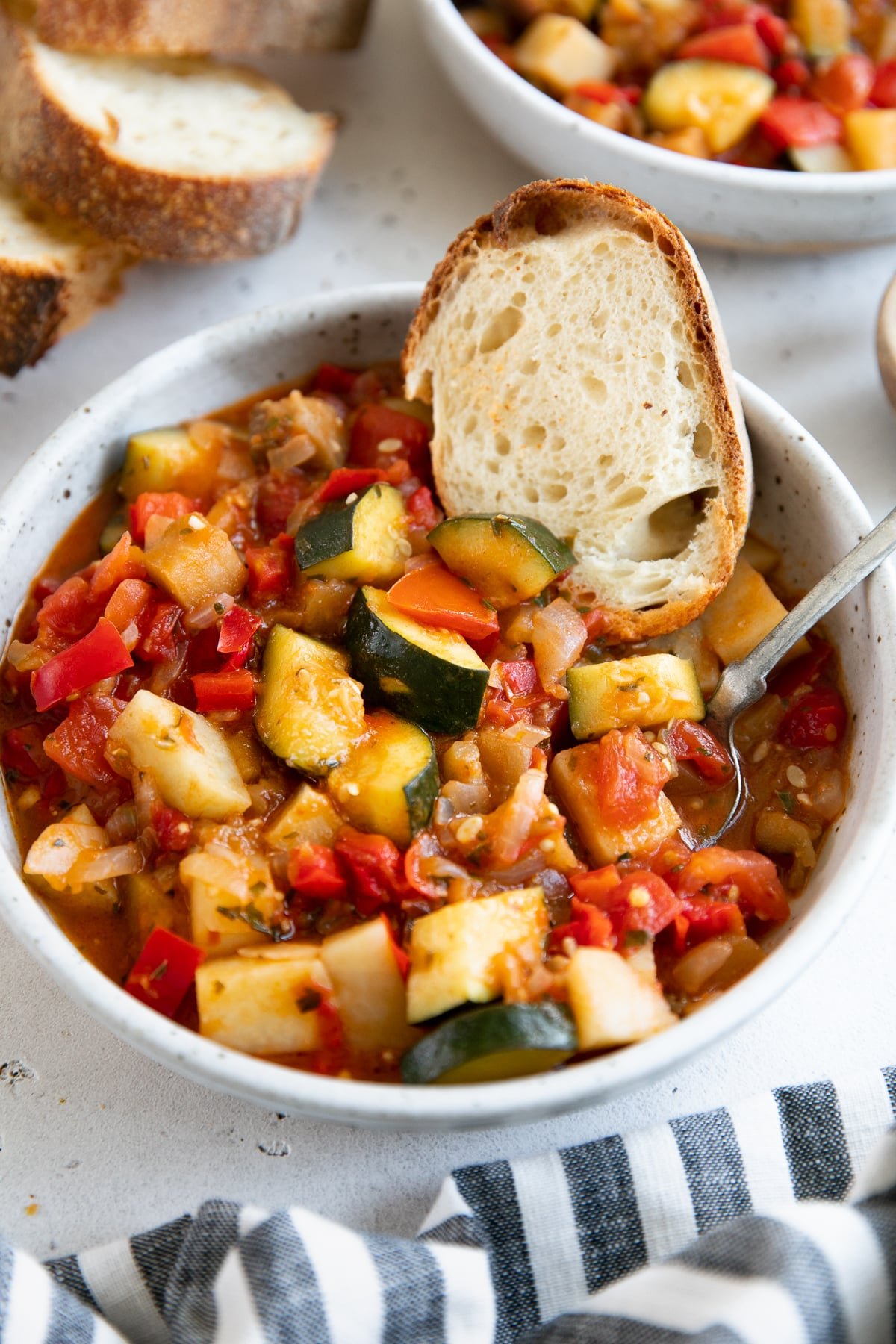
Italian Ratatouille Recipe
Ratatouille was, for a long time, one of those super intimidating recipes that I had zero desire to learn how to make. Until one day I found myself with an eggplant and a few zucchini gifted to me from a dear neighbor’s garden.
She recommended I make ratatouille. So, I did.
You guys, I soon realized that I knew nothing about ratatouille. My idea that this vegetable stew was difficult to make was so very wrong.
A little time-consuming? Yes. But difficult? No. I recommend making a big batch to enjoy all week long with mashed potatoes, poached eggs, cheese, fresh bread, rice, and all your other favs!
Table of Contents
- Italian Ratatouille Recipe
- What is Ratatouille?
- Difference between Ratatioulle and Ciambotta
- Key Ingredients
- How to Make Ratatouille so the vegetables aren’t mushy
- How to make Ratatouille
- Frequently Asked Questions
- What to serve with Ratatouille?
- Can you freeze leftover ratatouille?
- More vegetable recipes,
- Italian Ratatouille Recipe (Ciambotta)
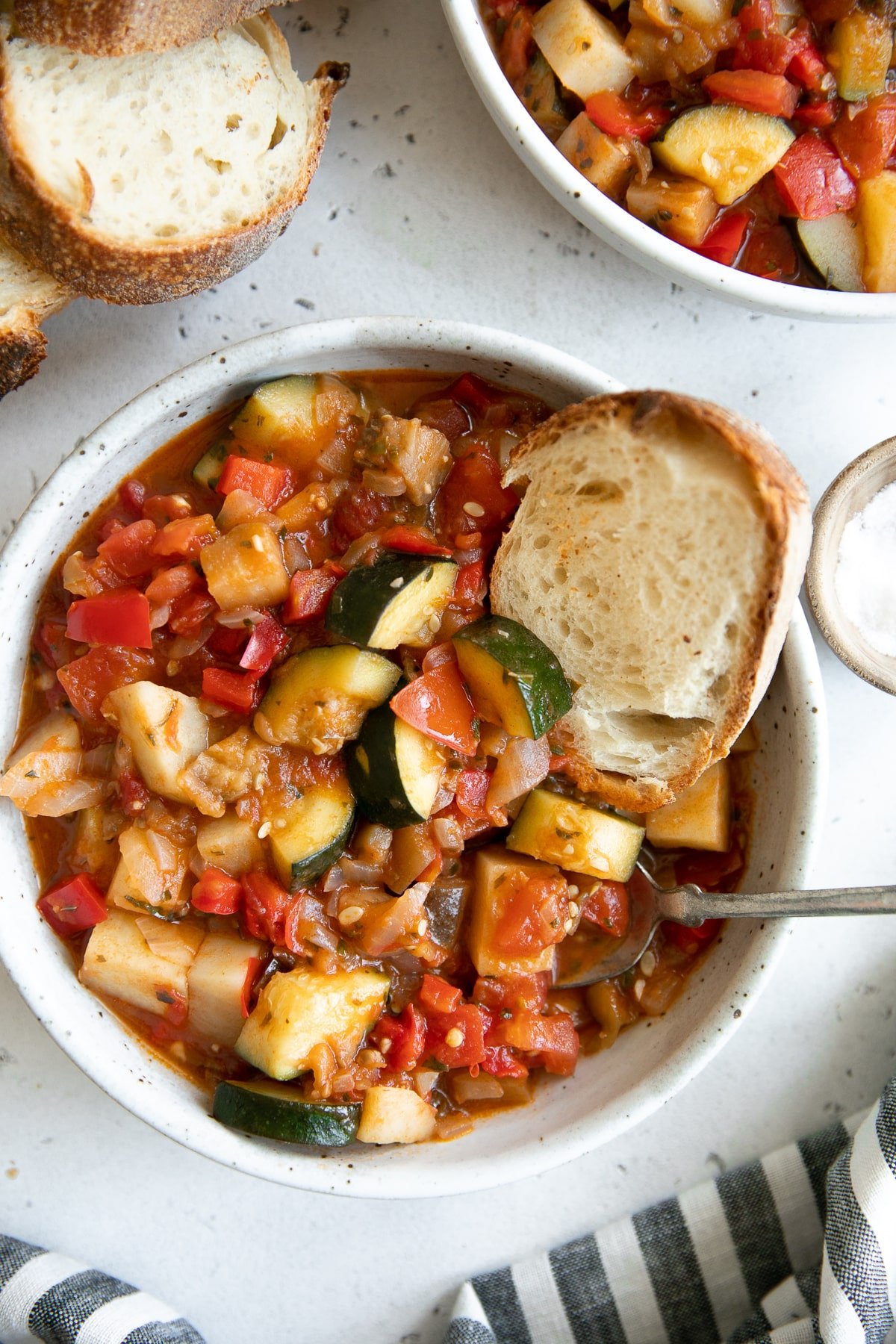
What is Ratatouille?
Ratatouille is a classic French Provençal stew made from fresh summer vegetables including tomatoes, eggplant, garlic, onion, zucchini, bell pepper, and some combination of fresh herbs. Recipe and cooking methods vary greatly, with many recipes nearly identical to the beloved classic and much more totally different.
Difference between Ratatioulle and Ciambotta
One recipe nearly identical to French ratatouille is an Italian vegetable stew called Ciambotta. Popular throughout southern Italy, ciambotta, like ratatouille, comes in many regional variations each which contain seasonal summer vegetables such as Italian eggplant, zucchini, bell peppers, onion, tomatoes, basil, garlic, and olive oil. One defining difference, however, is the presence of soft, buttery, chunks of potatoes.
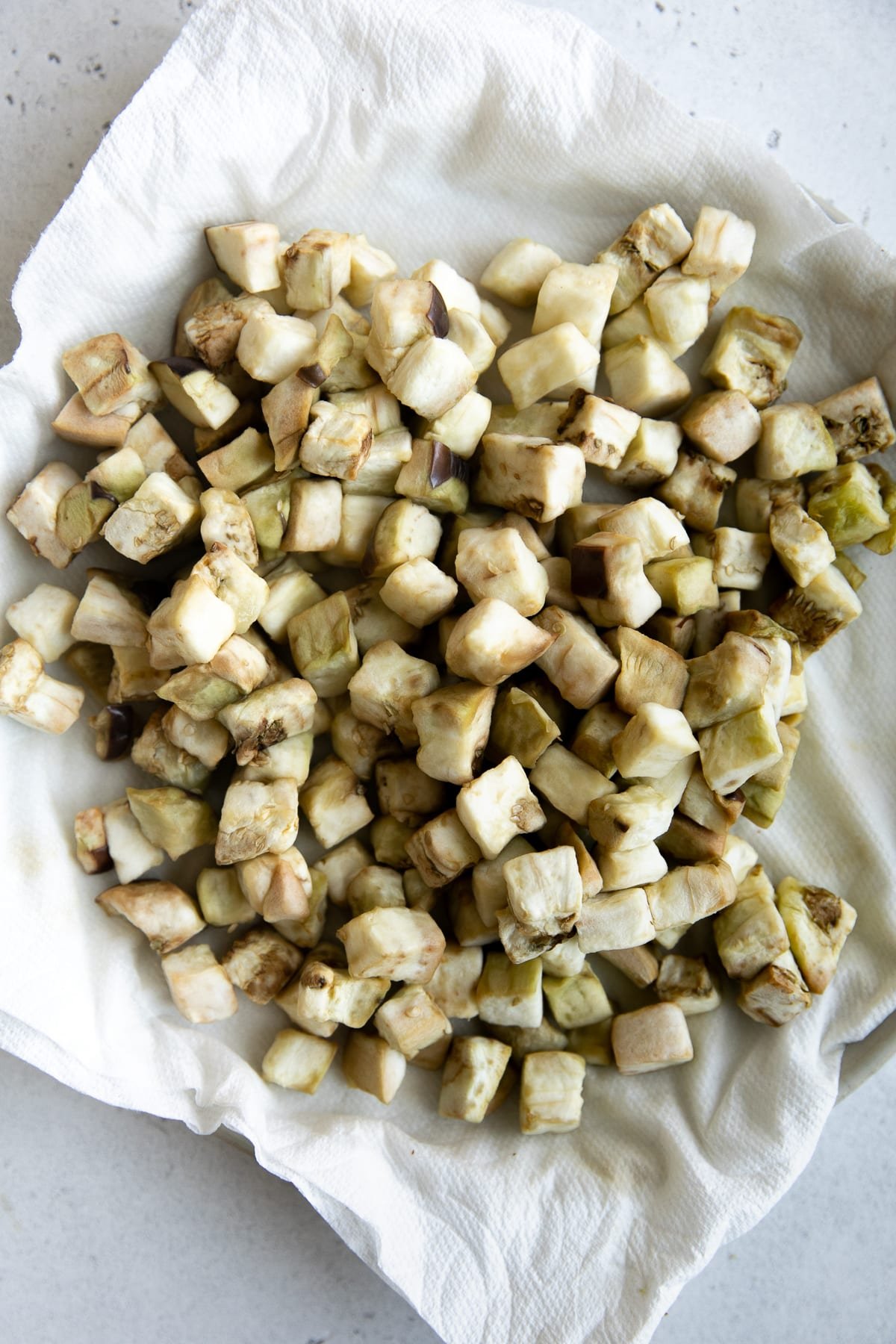
Key Ingredients
To make this ratatouille recipe you’ll need the following ingredients,
- Tomatoes – Tomatoes are classic to nearly every ratatouille recipe. Some people use only fresh tomatoes, some people use only canned tomatoes, and some people use a combination of both. Some recipes will suggest poaching and peeling the tomatoes before adding to the stew, while others simply chop and dump the tomato into the stew. Where am I going with this? Everyone will have their own opinions when it comes to tomatoes. If you want a more incorporated tomato sauce, use stewed, peeled tomatoes. If you want tomatoes that hold some shape, don’t peel them. If you want a little of both (oh hey! this recipe) use both.
- Vegetables – seasonal summer vegetables such as eggplant, zucchini, onion, and bell pepper.
- Olive oil – Different recipes will call for varying amounts of olive oil. I tried to prevent this recipe from becoming soggy or overwhelmed by olive oil. Not cooking the eggplant directly in olive oil helped prevent this.
- Herbs – Fresh basil is an absolute must. Additional herbs include fresh thyme and fresh oregano.
- Garlic – Blitz the garlic with your fresh herbs and olive oil in a small food processor and save tons of time.
- Potatoes – I added russet potatoes. Russet potatoes are starchier compared to Yukon Gold potatoes and, when cooked in acidic broths such as this tomato broth, have an easier time maintaining their shape. If you can’t find russet potatoes, red potatoes or Yukon gold potatoes will work just fine.
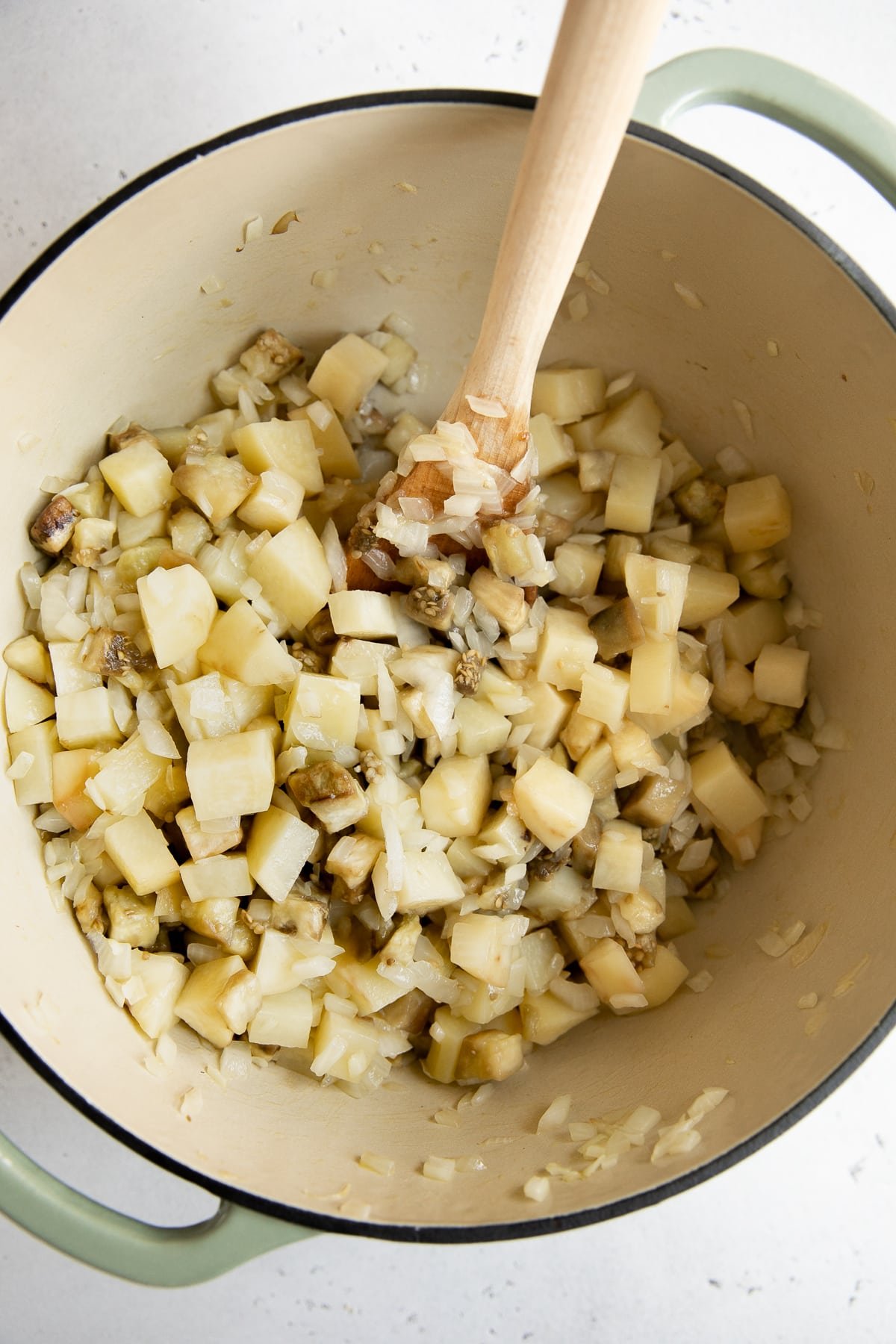
How to Make Ratatouille so the vegetables aren’t mushy
Do a little research on the internet (or a book…who are you?…kidding!) and you’ll immediately discover that there are many ways, and many many opinions, on the best way to cook ratatouille. I would love to tell you that this is, without a doubt, the best way to cook ratatouille, but I haven’t tried every single way yet, so I’m simply going with logic and expertise from other cooking masters (who have tried every way) and say that this is definitely one of the best ways. Why? The vegetables are not soggy, watery, mushy, or lacking in flavor.
How does one achieve these perfectly cooked vegetables?
Cook them in the right order. After all, all vegetables cook at different rates. And cook them individually.
For some of us, we can multi-task and cook several different vegetables at the same time and in different skillets, but for most of us, that gets too crazy.
In this particular recipe, you’re going to cook the onions, followed by the potatoes and pre-microwaved eggplant (more on this below) in the same pot at the same time. Once the onions are softened and potatoes just start to cook, you’ll build the tomato broth in the same pot, directly with the onions, potatoes, and eggplant.
This works because potatoes need time to simmer and soften. The eggplant, which was peeled, salted and microwaved before being added to the pot breaks down as it simmers, naturally thickening the sauce (a little trick I learned from Cook’s Illustrated).
And those extra watery vegetables – the zucchini and bell pepper?
- Seed your zucchini.
- Use a large skillet (not a pot with high sides) to cook them.
- Add them to a very HOT skillet.
- Remove them from the hot skillet and stop cooking before they are fully cooked.
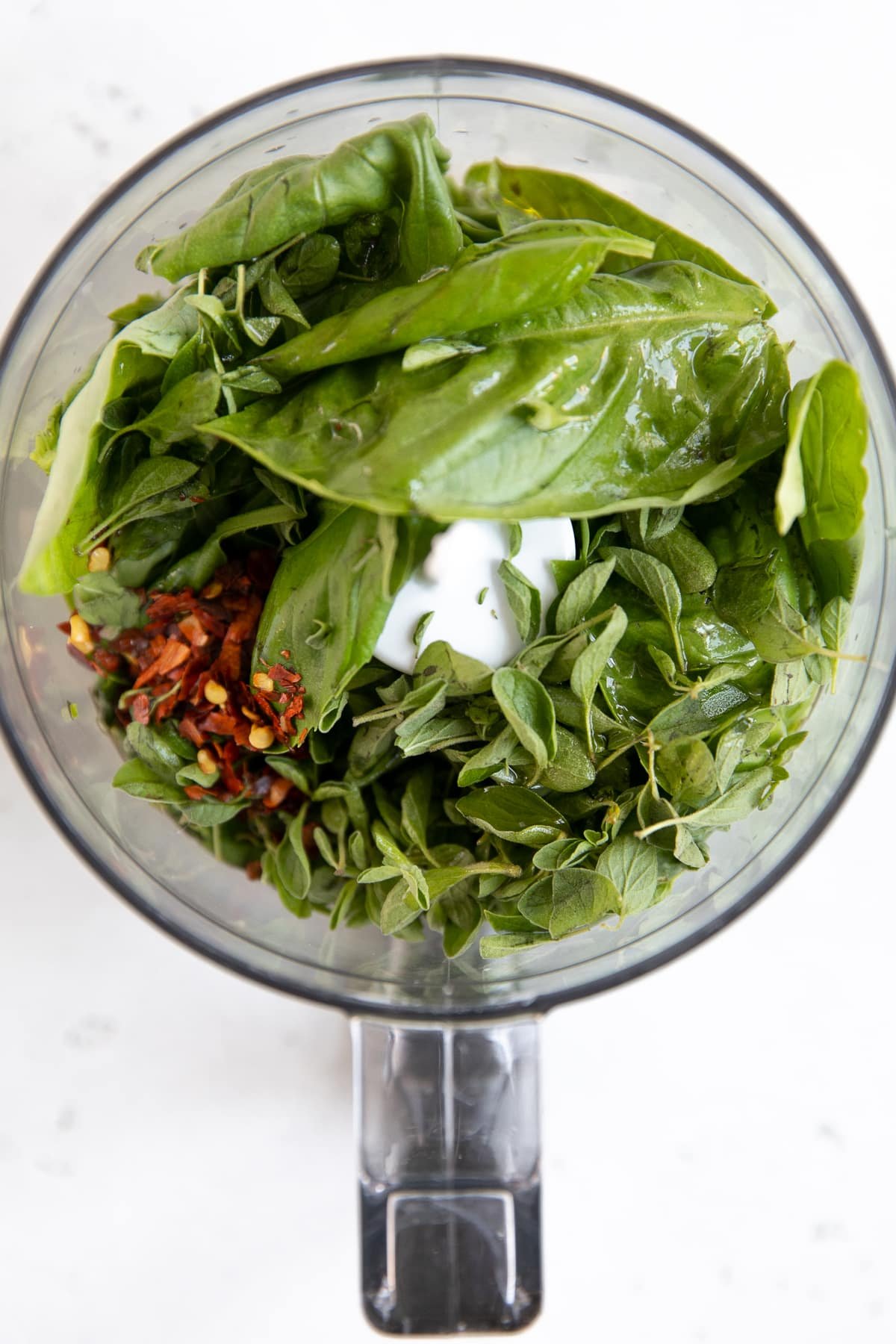
How to make Ratatouille
To make this fantastic ratatouille recipe follow these easy step-by-step instructions,
Step 1. Prepare the herb pesto – I like to make this herb and garlic mixture first to get it out of the way. Add the fresh basil, oregano, garlic, olive oil, and red pepper flakes (optional) to a small food processor. Blend until finely processed, scraping down the sides of the bowl as needed. Set aside.
Step 2. Microwave the eggplant – Transfer the eggplant pieces to a large bowl. Sprinkle with 1-2 teaspoons of salt and transfer to a large plate lined with paper towels. Microwave, uncovered, for 5-8 minutes, or until eggplant is dry to the touch and stars to shrivel.

Step 3. Cook the onions, potato, and eggplant – Heat a large Dutch oven or pot over medium heat. Add 2 tablespoons of olive oil and onions to the pot mixing well to combine. Cook the onions, stirring often, for 2-3 minutes. Add the potatoes and eggplant and cook, stirring frequently, for 4-6 minutes, or until onions are softened and the surface of the potatoes are translucent (they will not be fully cooked).
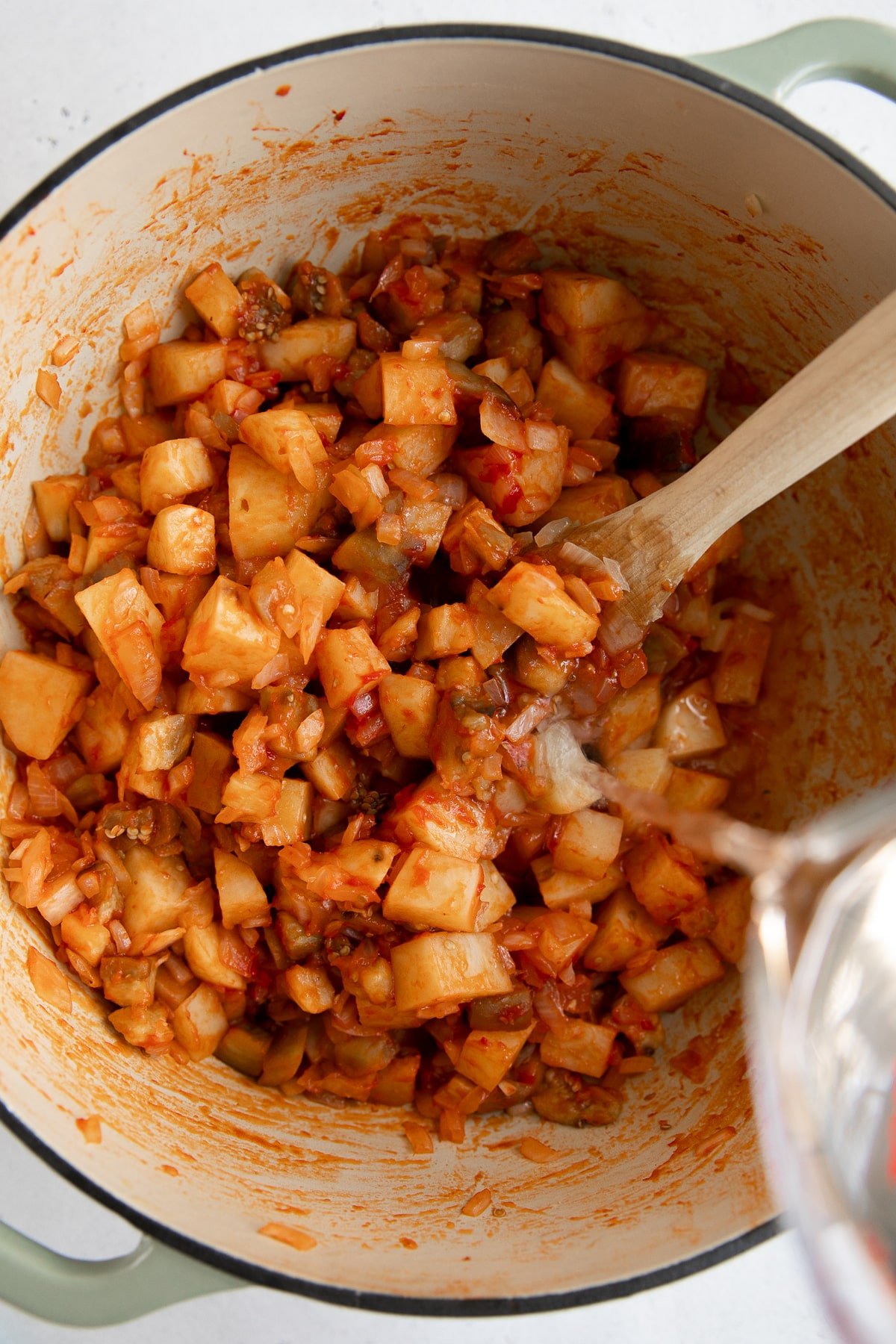
Step 4. Work in the tomatoes and make a broth – Push the potatoes and onion to the side of the pot. Add the tomato paste and 1 tablespoon of olive oil to the other side. Cook the tomato paste, whisking continuously, until a brown fond (the browned bits) forms on the bottom of the pot. This will take approximately 2 minutes. Still stirring, add the water to the pot and scrape the brown bits from the bottom of the pot. Add the canned tomatoes with their juice and fresh chopped tomatoes. Mix well. Bring to a boil.
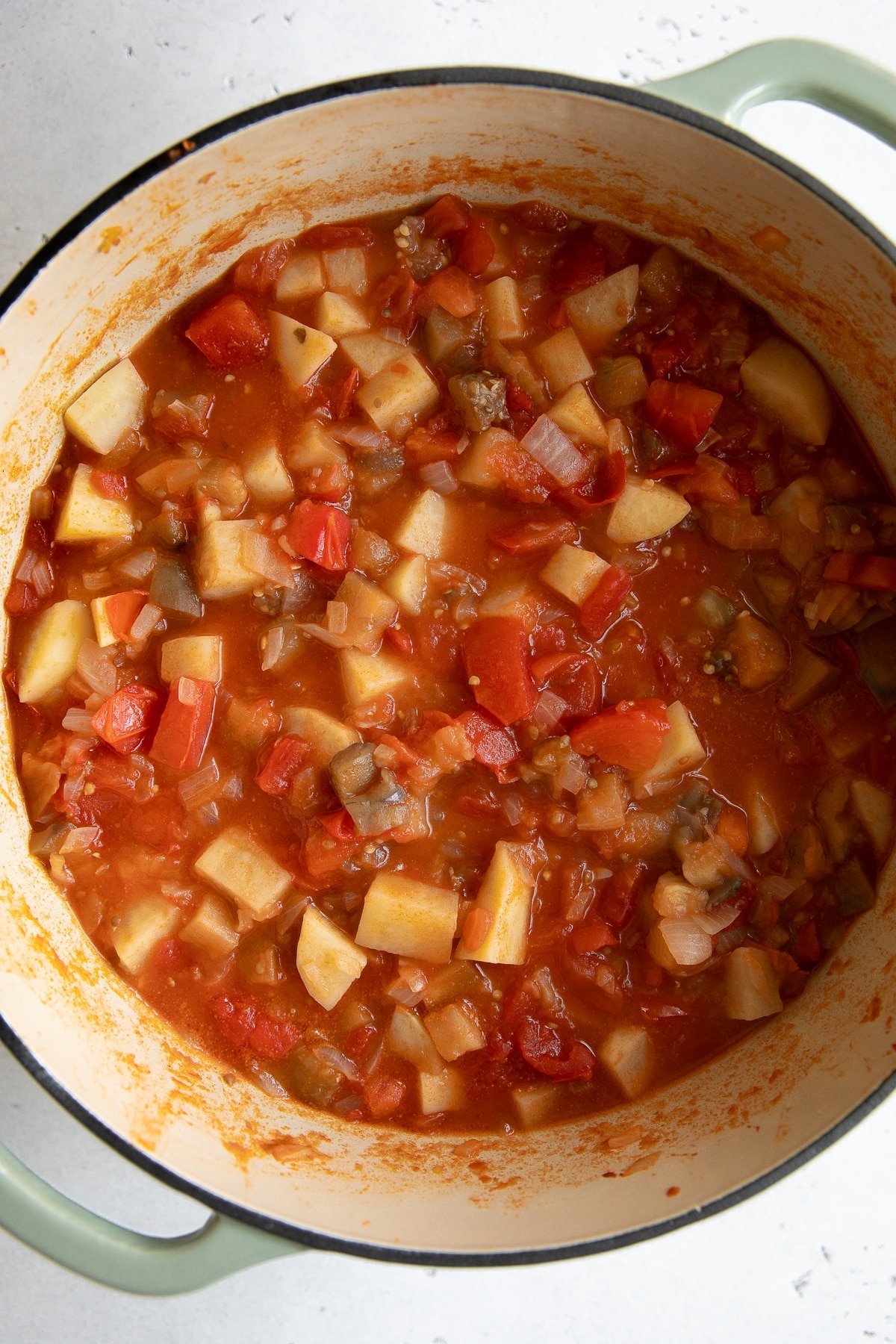
Step 5. Simmer – Reduce heat and bring to a simmer. Cook until the potatoes are tender and soft and the eggplant is broken down, approximately 25 minutes (the eggplant will help thicken the broth).
Step 6. Cook the zucchini and bell pepper – As the stew simmers, add the remaining tablespoon of olive oil to a large skillet over high heat. Allow your skillet to get really hot before adding the zucchini, yellow squash, and bell pepper. Sprinkle with salt and cook, stirring occasionally, until just softening.
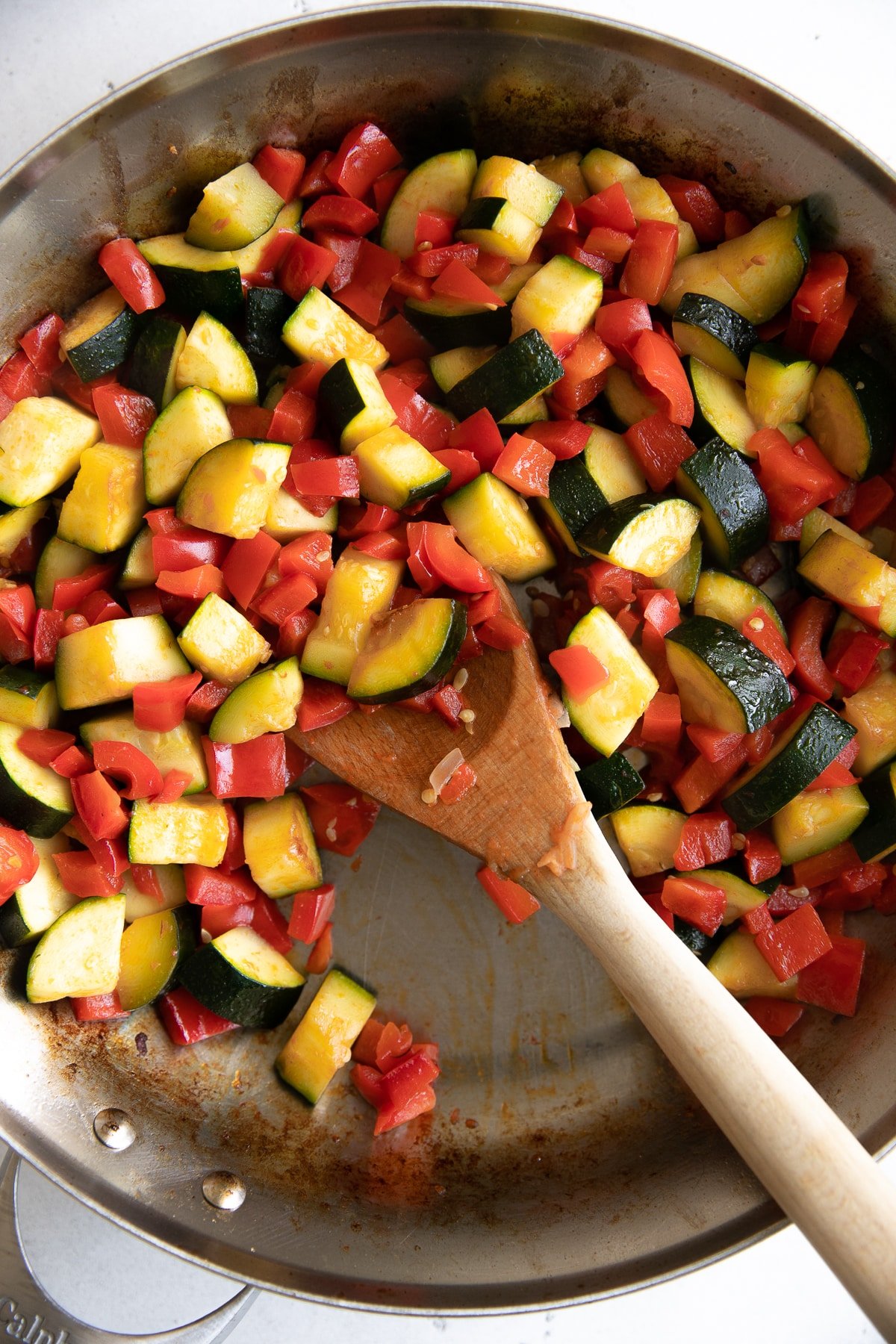
Step 7. Add the herb pesto to the zucchini and bell pepper – Create a well in the middle of the zucchini and bell pepper. Add the herb pesto and cook until fragrant (you guys, it will smell so good!) before stirring to combine with the zucchini and bell peppers. Remove from heat. If the potatoes are not yet soft, remove the zucchini and bell peppers from the skillet and set aside to a cool, clean plate.
Step 8. Combine – Once your potatoes are soft, add the zucchini and bell pepper mixture to the pot. Remove the entire pot from heat and mix well to combine. Cover and allow flavors to combine for at least 10 minutes before serving. Serve with freshly toasted bread.
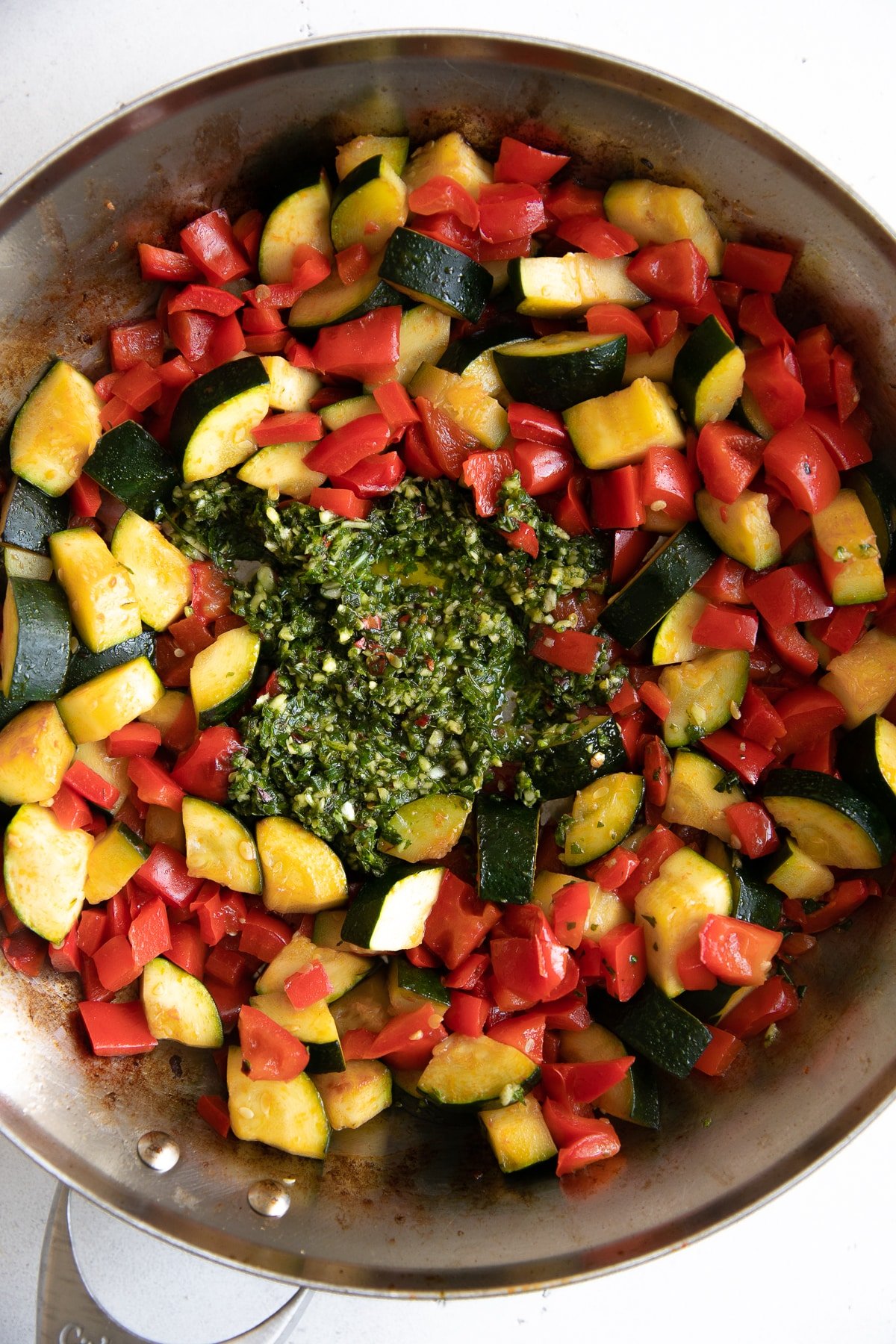
Frequently Asked Questions
No. However, the benefit of microwaving the eggplant is that it removes the moisture and starts the cooking process. If you choose not to microwave your eggplant, and simply cook it in the pot with olive oil, the eggplant will absorb the olive oil like a sponge which is neither appealing or tasty. The eggplant, after microwaving, will also act as a natural thickener, dissolving throughout the entire stew.
Fond is the brown bits that stick to your pan after browning meat or vegetables on the stovetop, or at the bottom of a roasting dish out of the oven. These brown bits may look unappealing but are actually loaded with flavor.
Of course not. However, the benefit is that the flavors have the opportunity to mix and meld with each other. This is especially important for the herb mixture that had just been added to the potatoes.
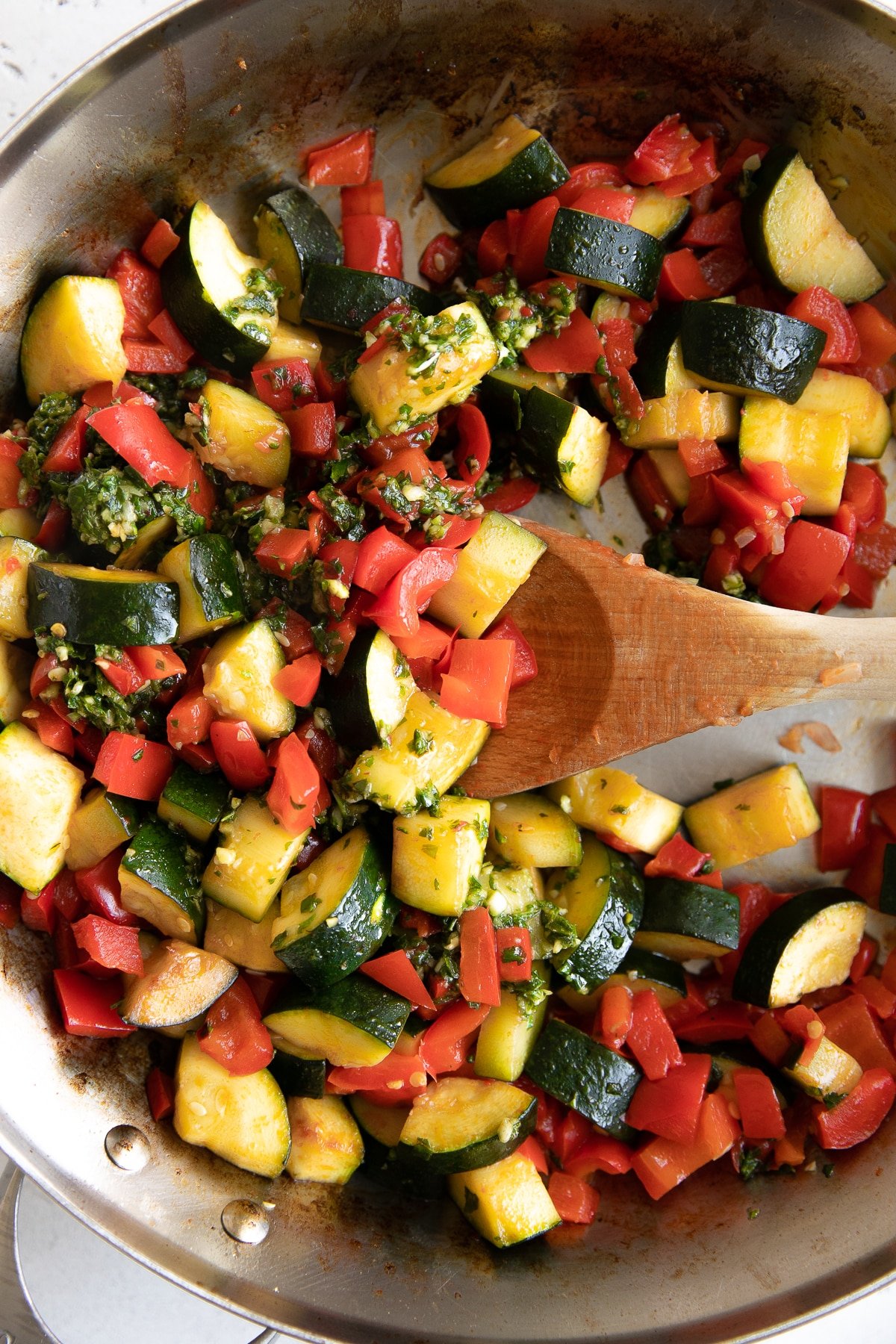
What to serve with Ratatouille?
You’ll find that ratatouille is so much more than just a bunch of cooked vegetables. Here are a few of my favorite ways to enjoy this awesome recipe:
- Topped with cheese – any and all cheese is delicious, but grated parmesan, goat cheese, or feta are my top picks.
- Make a ratatouille-style shakshuka or simply enjoy it topped with poached eggs.
- Serve with your favorite protein or grilled fish, including Lamb Chops Marinade, Pork Chops, or Baked Chicken Thighs.
- With my personal favorite, Mashed Cauliflower (or regular Mashed Potatoes).
- Tossed with plain, cooked pasta noodles.
- Spread over freshly toasted bread.
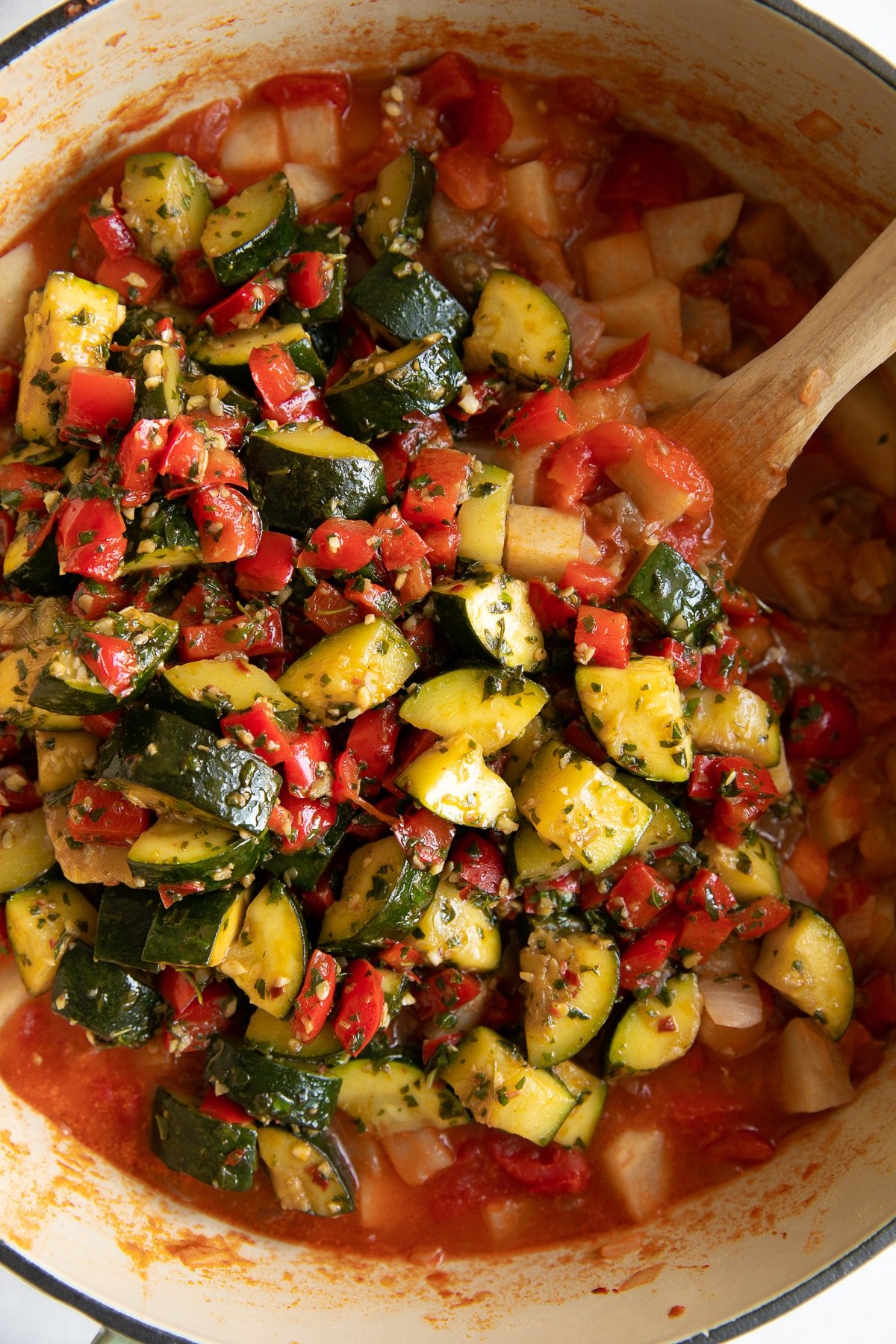
Can you freeze leftover ratatouille?
This Italian ratatouille recipe is not only phenomenal the next day or even two to three days later, but also delicious frozen and reheated.
To freeze, transfer your cooked and cooled ratatouille recipe to a freezer-safe zip-lock bag or container, removing as much air as possible. Transfer to the freezer for up to 3-4 months. When ready to enjoy, allow it to thaw in the refrigerator overnight and reheat in the microwave, on the stovetop, or enjoy cold.
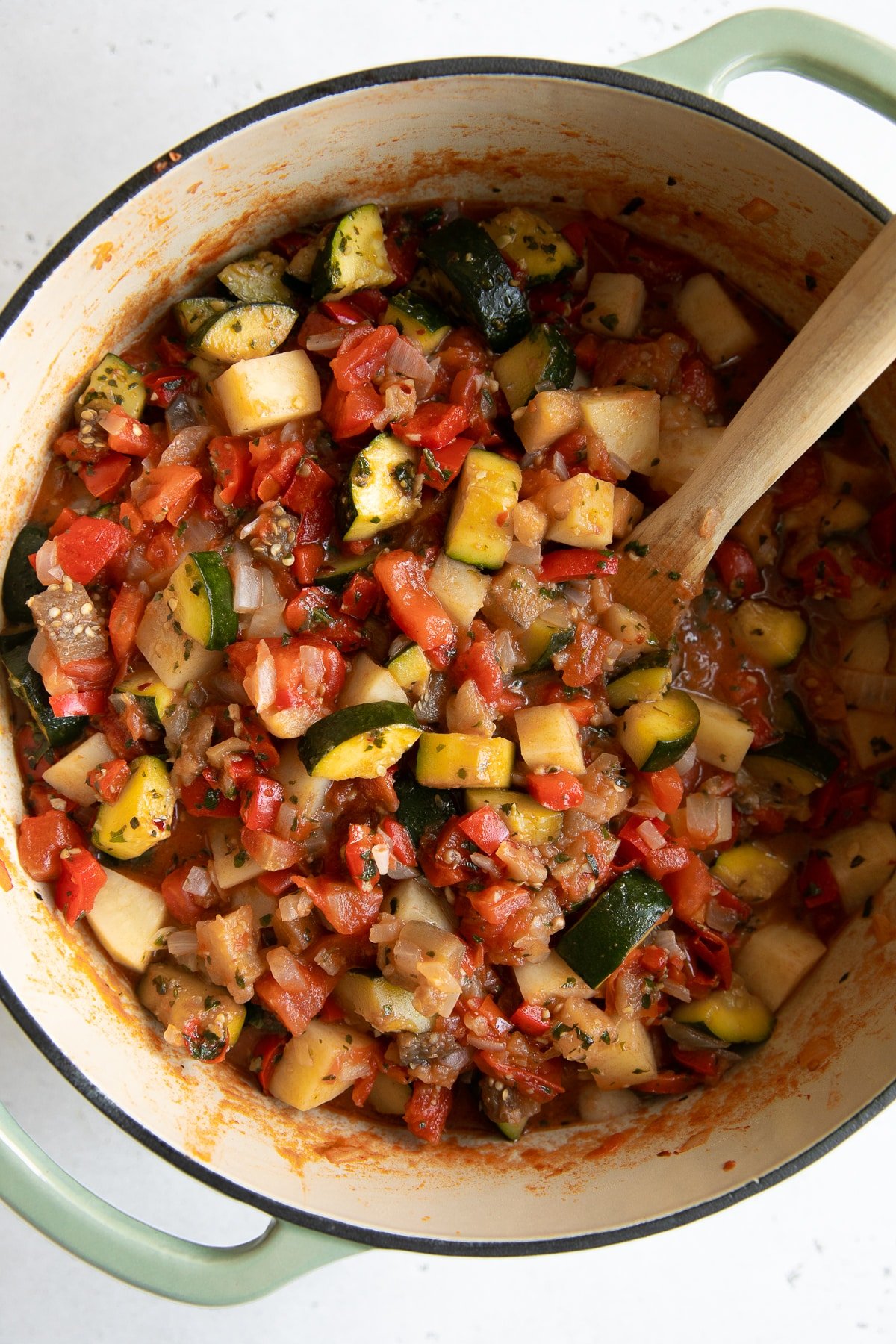
More vegetable recipes,
- Vegetarian Cauliflower Tikka Masala Recipe (Instant Pot)
- Easy Pasta Primavera Recipe
- Bruschetta Recipe with Tomato and Basil
- Easy Gazpacho Recipe (Gazpacho Andaluz)
- Bok Choy Recipe
- Homemade Vegetable Soup Recipe
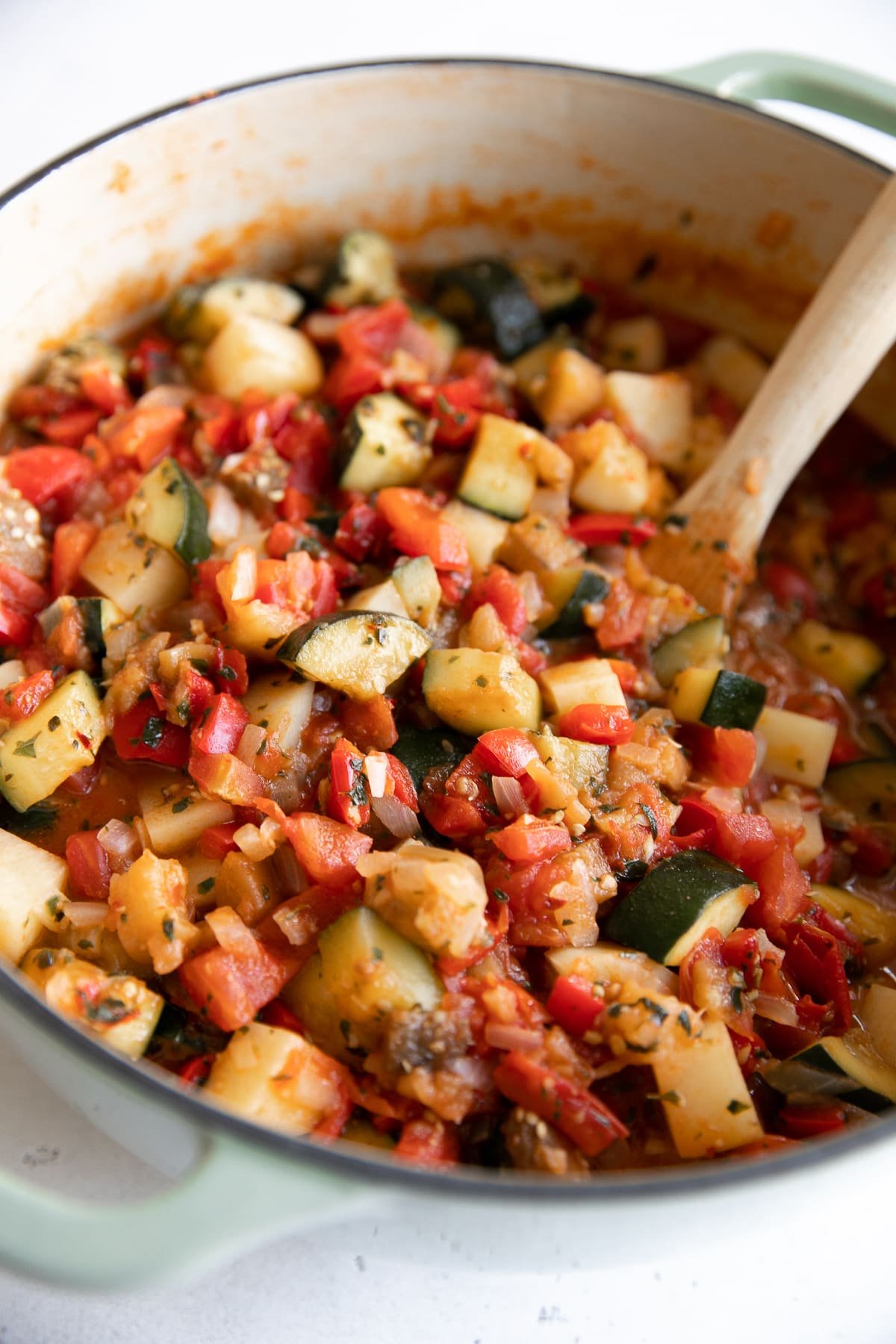
If you try making this Ratatouille Recipe, please leave me a comment and let me know! I always love to hear your thoughts.
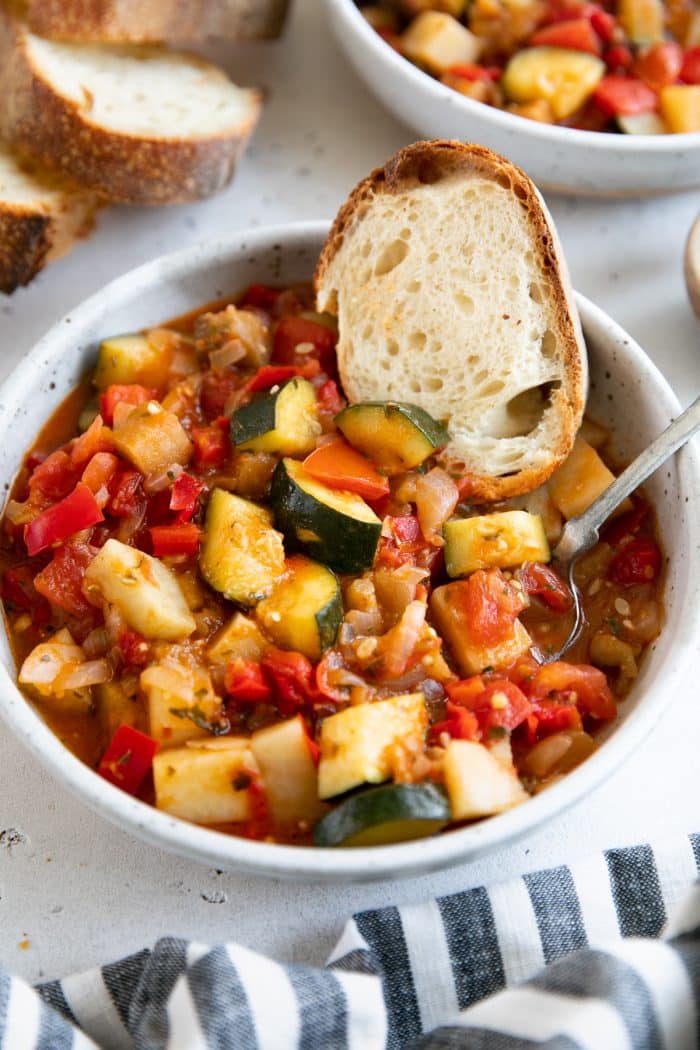
Italian Ratatouille Recipe (Ciambotta)
Ingredients
For the Herb Pesto
- ½ cup fresh basil, packed
- ⅓ cups fresh oregano leaves
- 8 cloves garlic, peeled and smashed
- 2 tablespoon olive oil
- ½ teaspoon red pepper flakes, (optional)
For the Italian Ratatouille (Ciambotta)
- 1 large eggplant, peeled (optional) and chopped into ½-inch pieces
- Salt
- ¼ cup olive oil, divided
- 2 medium onions, chopped
- 2 large russet potatoes, peeled and chopped into ½-inch pieces
- 3 tablespoon tomato paste
- 2½ cups water
- 1 (28 ounce) can whole peeled tomatoes with juice, tomatoes roughly chopped
- 2 large fresh tomatoes, chopped
- 2 large zucchini, seeded and chopped
- 1 yellow squash, seeded and chopped
- 2 bell peppers (yellow, red, or orange), stemmed, seeded, and diced
Instructions
For the Herb Pesto
- Prepare the herb pesto – Add the fresh basil, oregano, garlic, olive oil, and red pepper flakes (optional) to a small food processor. Blend until finely processed, scraping down the sides of the bowl as needed. Set aside.
For the Italian Ratatouille (Ciambotta)
- Cook the eggplant – Transfer the eggplant pieces to a large bowl. Sprinkle with 1-2 teaspoons of salt and transfer to a large plate lined with paper towels. Microwave, uncovered, for 5-8 minutes, or until eggplant is dry to the touch and starting to shrivel. Set aside (see notes).
- Cook the onions, potato, and eggplant – Heat a large Dutch oven or pot over medium heat. Add 2 tablespoons of olive oil and onions to the pot mixing well to combine. Cook the onions, stirring often, for 2-3 minutes. Add the potatoes and eggplant and cook, stirring frequently, for 4-6 minutes, or until onions are softened and the surface of the potatoes are translucent (they will not be fully cooked).
- Work in the tomatoes and make a broth – Push the potatoes and onion to the side of the pot. Add the tomato paste and 1 tablespoon of olive oil to the other side. Cook the tomato paste, whisking continuously, until a brown fond (the browned bits) forms on the bottom of the pot (see notes). This will take approximately 2 minutes. Still stirring, add the water scraping the brown bits from the bottom of the pot. Add the canned tomatoes with their juice and fresh chopped tomatoes. Mix well. Bring to a boil.
- Simmer – Reduce heat and bring to a simmer. Cook until the potatoes are tender and soft and the eggplant is broken down, approximately 25 minutes (the eggplant will help thicken the broth).
- Cook the zucchini and bell pepper – As the stew simmers, add the remaining tablespoon of olive oil to a large skillet over high heat. Allow your skillet to get really hot before adding the zucchini, yellow squash, and bell pepper. Sprinkle with salt and cook, stirring occasionally, until just softening.
- Add the herb pesto to the zucchini and bell pepper – Create a well in the middle of the zucchini and bell pepper. Add the herb pesto and cook until fragrant (oh my, goodness, it will smell so good!) before stirring to combine with the zucchini and bell peppers. Remove from heat.
- Combine – Once potatoes are soft, add the zucchini and bell pepper mixture to the pot. Remove from heat and mix well to combine. Cover and allow flavors to combine for at least 10 minutes before serving. Serve with freshly toasted bread.
Notes
- What is the “fond” – Fond is the brown bits that stick to your pan after browning meat or vegetables on the stove top, or at the bottom of a roasting dish out of the oven. These brown bits may look unappealing, but are actually loaded with flavor.
Nutrition
Nutrition information is automatically calculated, so should only be used as an approximation.


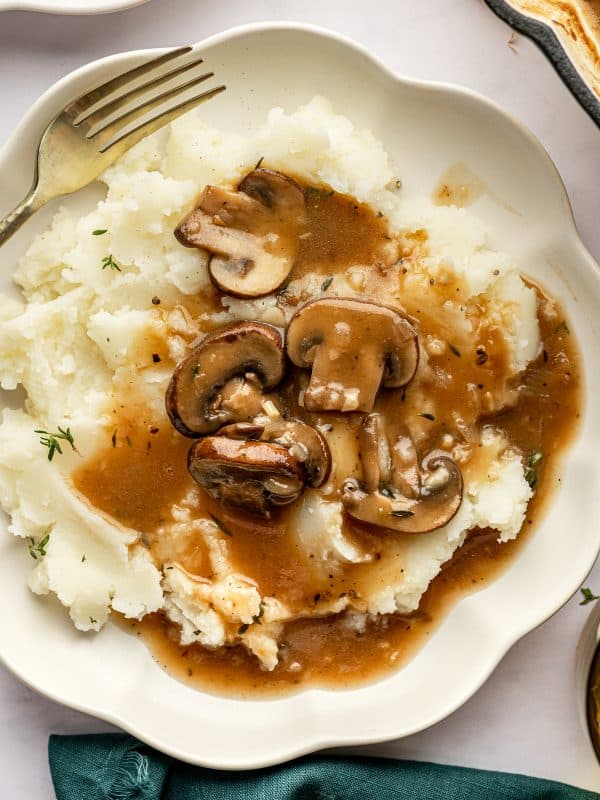
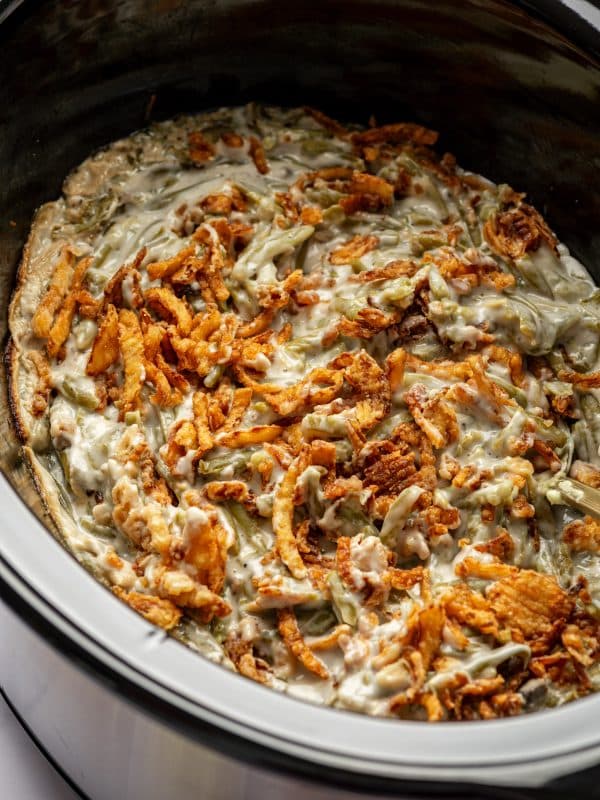
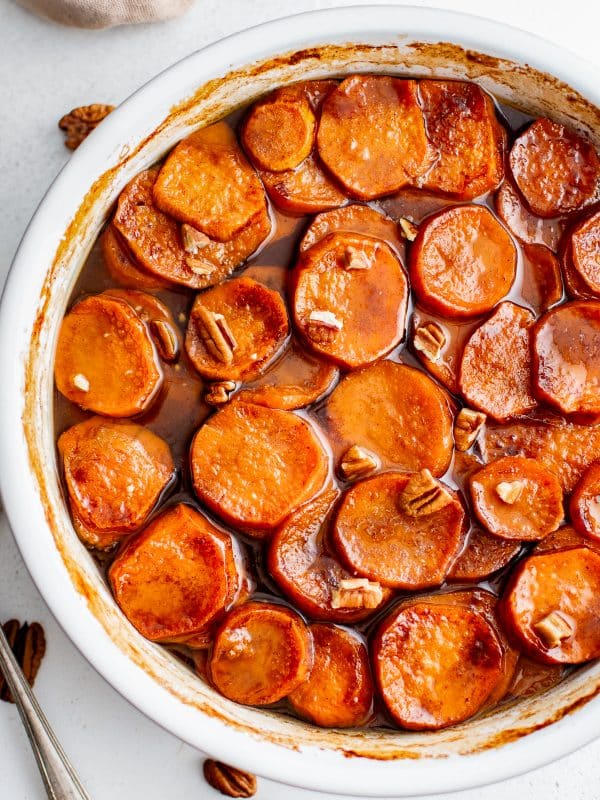
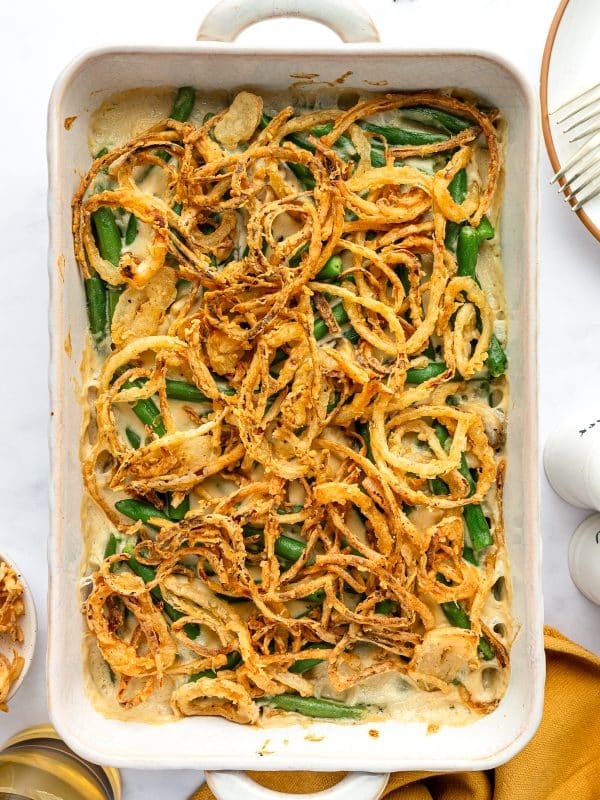








Favoloso encroyable Chapeux!
I used 3 summer squash and no zucchini as my husband is not a zucchini fan. He is not super familiar with eggplant but even though I told him it had eggplant he tried it with an open mind. He had seconds. I was surprised that the potatoes seemed to almost never cook (maybe took an hour). I think I would par-boil them next time before putting them in the recipe. I’ve never had potatoes in this dish but it was a great addition. I will definitely make this again, soon.
Thanks Jane 🙂
I used to make ratatouille and my husband and my children complained about it. I tried to convince them that it was so nutritious and to try to enjoy it. Well, today I saw your recipe and decided to make it. My husband was not looking forward to dinner. Well, that has all changed. The fresh basil, oregano and 8 garlic cloves made all the difference.We both LOVED it! Delicious!
Thanks for the delicious feedback, Robin 🙂
This recipe was time consuming but very well worth it. I rarely write reviews, but this recipe was phenomenal!! It rivals any restaurant ratatouille that I’ve ever tasted. Thank you! I am a fan!
Thanks, Dianne, some things are definitely worth the effort, and this is one of them 🙂
Tasty and delicious, and the whole family loved it. I should have cooked the potatoes a bit longer but I just simmered longer at the end, which enabled the flavors to develop longer anyway so that wasn’t a bad thing. My prep time was much longer than indicated, but I figured that would be the case once I read the recipe. I served with sliced baguette toasted in the oven. I will definitely be passing along this recipe. Thanks!
Thanks for the kind comment Noelle 🙂
Great ratatouille recipe with clear directions and helpful tips. Made it today and decided to double the recipe for sharing. Next time I will be sure to use fresh oregano leaves, as I only had dried oregano for the pesto and worried about the ratio – but the dish still tasted great. Nice flavors and fresh tasting. Served the ratatouille with grated fresh parmesan cheese and a nice crusty bread. My prep time was quadruple the estimated time but totally worth it.